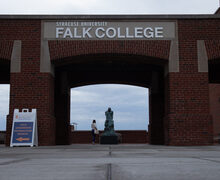Letter to the Editor : Campus should know recycling rules for Onondaga County
If you walked between the Schine Student Center and the S.I. Newhouse School of Public Communications last week, you may have noticed the blue recycling bins, empty plastic bottles, cereal boxes and a random cottage cheese container lining the grass area. The bottles and other items are part of a recycling display set up by the Syracuse University Sustainability Division in an effort to bring more awareness to the community about recycling on campus. The ultimate goal is to make sure if a product is recyclable it gets recycled instead of thrown in the trash.
The display taught me a couple of quick facts that will come in handy next time I — or preferably my roommate — have to sort the recycling. For example, I learned that aluminum foil, aseptic containers (fancy words for soy milk carton) and only plastics No. 1 and No. 2 bottleneck containers, like laundry detergent, and No. 5 plastics can be recycled. Bottle caps, produce containers and paper and cardboard items with food or grease stains cannot be recycled.
Perhaps some of the biggest misconceptions most students have about recyclable materials on campus are what to do with the infamous pizza boxes and with the daily plastic iced coffee or tea containers. I have always flattened pizza boxes and reluctantly put them out for recycling; however, I now know that most of those boxes broke the no- grease-stains rule and were not recyclable. A simple solution for this problem is to cut off the top half of the pizza box, which usually isn’t stained, and to recycle that part of the box.
The recycling of plastic Starbucks and Dunkin’ Donut cups, on the other hand, can be a bit more trivial. First of all, you need to check if the plastic cup has a recycling symbol with the No. 5 on it. If it does, it should be emptied out and rinsed before placing in the recycling bin. The tall plastic cups at Starbucks, for example, are recyclable because they are a No. 5, but the small plastic cups are not because they are a No. 1 and do not fall under the bottleneck category. So much to learn, but it’s easy once you understand.
This display and other recycling efforts and initiatives on campus are a great way to help Syracuse University undergraduate students — 11,800 of them — who come from all 50 states and more than 100 countries, along with the 5,000 graduate students, understand the recycling law in Onondaga County.
Michele Cantos
Senior international relations and public relations major
Published on October 4, 2011 at 12:00 pm




